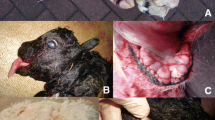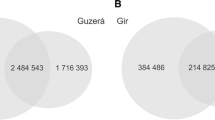Abstract
Mutations in caspase recruitment domain 15 (CARD15) are associated with susceptibility to Crohn’s disease and Blau Syndrome. We performed comparative analyses of the bovine, murine, and human CARD15 transcripts to elucidate functionality of bovine CARD15 and examine its potential role in bovine disease resistance. Comparative analyses of intronic sequence across seven divergent species were performed to identify putative regulatory element binding motifs. High levels of interspecies conservation in sequence, genomic structure, and protein domains were detected indicating common functionality for CARD15 in cattle, human, and mouse. We identified species-specific regulatory elements in the 5′ and 3′ untranslated regions, suggesting that modes of regulation may have diverged across species. Thirty-one conserved putative regulatory element binding motifs were identified in the CARD15 intronic sequence of seven species. To assess the extent of genetic diversity within bovine CARD15, 41 individuals from two subspecies were sequenced and screened for polymorphisms. Thirty-six single nucleotide polymorphisms (SNPs) were identified. Finally, 20 subspecies-specific haplotypes were predicted with 7 and 13 unique haplotypes explaining the diversity within B. taurus taurus and B. taurus indicus animals, respectively. Strong evidence for a simple causal relationship between these SNP loci and their haplotypes with Johne’s disease was not detected.

Similar content being viewed by others
References
Borchert A, Savaskan NE, Kuhn H (2003) Regulation of expression of the phospholipid hydroperoxide/sperm nucleus glutathione peroxidase gene. Tissue-specific expression pattern and identification of functional cis- and trans-regulatory elements. J Biol Chem 278, 2571–2580
Brend T, Gilthorpe J, Summerbell D, Rigby PW (2003) Multiple levels of transcriptional and post-transcriptional regulation are required to define the domain of Hoxb4 expression. Development 130, 2717–2728
Chevalet C, Corpet F (1986) Statistical decision rules concerning synteny or independence between markers. Cytogenet Cell Genet 43, 132–139
Chiodini RJ (1989) Crohn’s disease and the mycobacterioses: a review and comparison of two disease entities. Clin Microbiol Rev 2, 90–117
Cocito C, Gilot P, Coene M, de Kesel M, Poupart P, Vannuffel P (1994) Paratuberculosis. Clin Microbiol Rev 7, 328–345
Giacopelli F, Rosatto N, Divizia MT, Cusano R, Caridi G, et al. (2003) The first intron of the human osteopontin gene contains a C/EBP-beta-responsive enhancer. Gene Expr 11, 95–104
Girardin SE, Boneca IG, Carneiro LA, Antignac A, Jehanno M, et al. (2003) Nod1 detects a unique muropeptide from gram-negative bacterial peptidoglycan. Science 300, 1584–1587
Gutierrez O, Pipaon C, Inohara N, Fontalba A, Ogura Y, et al. (2002) Induction of Nod2 in myelomonocytic and intestinal epithelial cells via nuclear factor-kappa B activation. J Biol Chem 277, 41701–41705
Heaton MP, Grosse WM, Kappes SM, Keele JW, Chitko-McKown CG, et al. (2001) Estimation of DNA sequence diversity in bovine cytokine genes. Mamm Genome 12, 32–37
Hugot JP, Chamaillard M, Zouali H, Lesage S, Cezard JP, et al. (2001) Association of NOD2 leucine-rich repeat variants with susceptibility to Crohn’s disease. Nature 411, 599–603
Inohara N, Nunez G (2001) The NOD: a signaling module that regulates apoptosis and host defense against pathogens. Oncogene 20, 6473–6481
Iwanaga Y, Davey MP, Martin TM, Planck SR, DePriest ML, et al. (2003) Cloning, sequencing and expression analysis of the mouse NOD2/ CARD15 gene. Inflamm Res 52, 272–276
Jukes TH, Cantor CR (1969) Evolution of protein molecules. In: Mammalian Protein Metabolism, Munro HN (ed.) (New York: Academic Press), pp 21–132
King K, Sheikh MF, Cuthbert AP, Fisher SA, Onnie CM, et al. (2006) Mutation, selection, and evolution of the Crohn disease susceptibility gene CARD15. Hum Mutat 27, 44–54
Miceli-Richard C, Lesage S, Rybojad M, Prieur AM, Manouvrier-Hanu S, et al. (2001) CARD15 mutations in Blau syndrome. Nat Genet 29, 19–20
Niu T, Qin ZS, Xu X, Liu JS (2002) Bayesian haplotype inference for multiple linked single-nucleotide polymorphisms. Am J Hum Genet 70, 157–169
Ogura Y, Bonen DK, Inohara N, Nicolae DL, Chen FF, et al. (2001a) A frameshift mutation in NOD2 associated with susceptibility to Crohn’s disease. Nature 411, 603–606
Ogura Y, Inohara N, Benito A, Chen FF, Yamaoka S, et al. (2001b) Nod2, a Nod1/Apaf-1 family member that is restricted to monocytes and activates NF-kappaB. J Biol Chem 276, 4812–4818
Ogura Y, Saab L, Chen FF, Benito A, Inohara N, et al. (2003) Genetic variation and activity of mouse Nod2, a susceptibility gene for Crohn’s disease. Genomics 81, 369–377
Slonim D, Kruglyak L, Stein L, Lander E (1997) Building human genome maps with radiation hybrids. J Comput Biol 4, 487–504
Thompson DE (1994) The role of mycobacteria in Crohn’s disease. J Med Microbiol 41, 74–94
Van Laere AS, Nguyen M, Braunschweig M, Nezer C, Collette C, et al. (2003) A regulatory mutation in IGF2 causes a major QTL effect on muscle growth in the pig. Nature 425, 832–836
Womack JE, Moll YD (1986) Gene map of the cow: conservation of linkage with mouse and man. J Hered 77, 2–7
Womack JE, Johnson JS, Owens EK, Rexroad CE III, Schlapfer J, et al. (1997) A whole-genome radiation hybrid panel for bovine gene mapping. Mamm Genome 8, 854–856
Acknowledgments
The authors gratefully acknowledge the assistance and support of Janice Elliott. This work was supported by a Programs of Excellence grant from the Life Sciences Task Force of Texas A&M University, USDA-CREES NRI grant 99-35205-8534, US DHS BAA-ONR grant N00014-04-1-0 from the Department of Homeland Security, and grant 517-0186-2001 from the State of Texas Advanced Technology Program.
Author information
Authors and Affiliations
Corresponding author
Electronic Supplementary Material
Rights and permissions
About this article
Cite this article
Taylor, K.H., Taylor, J.F., White, S.N. et al. Identification of genetic variation and putative regulatory regions in bovine CARD15 . Mamm Genome 17, 892–901 (2006). https://doi.org/10.1007/s00335-005-0148-2
Received:
Accepted:
Published:
Issue Date:
DOI: https://doi.org/10.1007/s00335-005-0148-2




